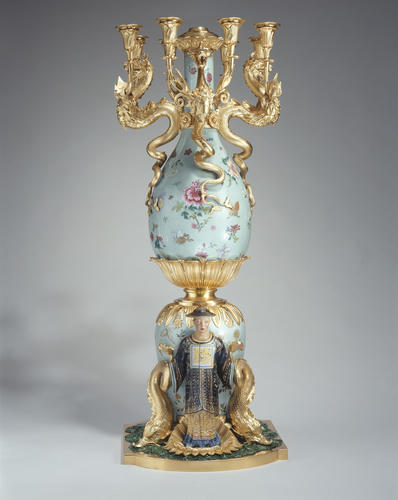Pair of bottle vases mounted as eight-light candelabra vases: 1780-1810, mounts: early 19th century
Porcelain with light celadon glaze painted in famille rose enamels and gilt, with gilt bronze | 116.0 x 47.0 x 51.0 cm (whole object) | RCIN 2736

China
Master: Pair of bottle vases mounted as eight-light candelabra vases: 1780-1810, mounts: early 19th century

China
Master: Pair of bottle vases mounted as eight-light candelabra vases: 1780-1810, mounts: early 19th century



-
Eight-light candelabra consisting of a Chinese porcelain vase fitted with English gilt-bronze mounts. Pear-shaped, the tall necks cut down and side handles apparently removed. The celadon glaze overpainted with flower sprays and butterflies, with a red and gilt spearhead border below the lip. Each upper rim is fitted with a projecting leaf-cast edge, with four redundant holes and two holes in the top surface, probably for ‘cut glass prismatic top ornaments’ now missing (1829B, p. 9 at the back), and fitted round the neck with a gilt-bronze collar with sunflowers supporting four writhing dragons, lacking their tongues, each with two candle branches with leaf-cups, their tails coiling down the sides. The base set in a deep lotus-petalled cup raised on a vase-shaped stand of metal, painted with flowers on a pale green ground to match the porcelain vases, with gilt-bronze leaves and flowers applied to the neck. In front of each stands a lifelike Chinese court official in painted metal, standing on a shell emerging from a lotus flower, one painted in a red robe, the other in a blue robe, his hands resting on a gilt-bronze dolphin on either side with coiled tail, attached to a base modelled, silvered and tinted in imitation of green waves. The figures feature on their robes rank badges with five-clawed dragons.
The vase is from the late eighteenth century or early nineteenth century. The gilt bronze mounts are by Samuel Parker and made in 1822.
They were destined for the mantelpiece of the chinoiserie fireplace in the Saloon at the Royal Pavilion, Brighton, with its inset mandarin figures, which was produced to Robert Jones’s design in 1816–23, and they are portrayed there in Pugin’s watercolour of 1823–4, flanking the so-called ‘Kylin’ clock (RCIN 2867). Samuel Parker’s invoice of 30 April 1822 notes: ‘A Magnificent sett of Ornaments gilt for chimney as per Estimate [£]840.0.0’; to this was added ‘For 2 Extra Vases 11 Inches [27.9 cm] Diameter by 16 In. [40.6 cm] high to Support the grand Candelabras’, as well as sundry decorative elements, additional to the original estimate. These extra items totalled £82 10s, and the full amount invoiced, which included his work on the chimneypiece, was £922 10s (Royal Archives GEO/MAIN/25372). Jones’s invoice of 27 June 1823 included ‘Designs for the Oriental Candelabra, which stand on the Chimneypiece, and appropriating China jars, and arranging by imitation other Jars, to connect and correspond, with the Design and Ornamental Colouring of the Porcelain Jars’, £162 (National Archives LC 11/41). The work was carried out by Samuel Parker, whom John Nash had recommended in 1822 as a cheaper alternative to Benjamin Lewis Vulliamy. The candelabra, metal stands and accompanying figures are described in the Inventory as having ‘cut glass prismatic top ornaments (1829B, p. 9 at the back) which have not survived.
Text adapted from Chinese and Japanese Works of Art in the Collection of Her Majesty The Queen: Volume II.Provenance
George IV, 1822. Recorded in the chimney in the Saloon at the Royal Pavilion, Brighton, as ‘A pair of very fine sea green bottles, beautifully enamelled in flowers and butterflies, mounted as Candelabras, with four ormolu Dragon branches for eight lights each, rich chased leaf tips, & cut glass prismatic top ornaments - the bottoms of the bottles resting in large ormolu Lotuses, on metal japanned Vases, painted to match the bottles, with leaf and flower ormolu top ornaments, supported in front by ormolu Dolphins, and japanned metal Chinese figures in foliage, shells - ormolu bases with circular fronts & backs, the surface, chased, silvered and tinted to represent Water, four feet six inches [137.2 cm]’ (1829B, p. 16). The mantelpiece and candelabra were transferred to Buckingham Palace in March 1847 (1829A, p. 35) and installed in the Yellow Drawing Room. Recorded in the Yellow Drawing Room at Buckingham Palace in 1921 (1829B, p. 16).
Exhibited in Chinese Whispers: Chinoiserie in Britain, 1650–1930, Brighton Museum and Art Gallery, Brighton, 2008. -
Creator(s)
(nationality)(metalworker)(metalworker)Acquirer(s)
-
Medium and techniques
Porcelain with light celadon glaze painted in famille rose enamels and gilt, with gilt bronze
Measurements
116.0 x 47.0 x 51.0 cm (whole object)
Other number(s)








